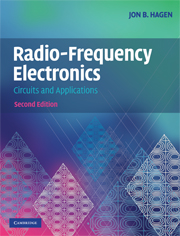Book contents
- Frontmatter
- Contents
- Preface
- 1 Introduction
- 2 Impedance matching
- 3 Linear power amplifiers
- 4 Basic filters
- 5 Frequency converters
- 6 Amplitude and frequency modulation
- 7 Radio receivers
- 8 Suppressed-carrier AM and quadrature AM (QAM)
- 9 Class-C, D, and E Power RF amplifiers
- 10 Transmission lines
- 11 Oscillators
- 12 Phase lock loops and synthesizers
- 13 Coupled-resonator bandpass filters
- 14 Transformers and baluns
- 15 Hybrid couplers
- 16 Waveguide circuits
- 17 Small-signal RF amplifiers
- 18 Demodulators and detectors
- 19 Television systems
- 20 Antennas and radio wave propagation
- 21 Radar
- 22 Digital modulation techniques
- 23 Modulation, noise, and information
- 24 Amplifier and oscillator noise analysis
- 25 The GPS Navigation system
- 26 Radio and radar astronomy
- 27 Radio spectrometry
- 28 S-parameter circuit analysis
- 29 Power supplies
- 30 RF test equipment
- Index
- References
19 - Television systems
Published online by Cambridge University Press: 05 June 2012
- Frontmatter
- Contents
- Preface
- 1 Introduction
- 2 Impedance matching
- 3 Linear power amplifiers
- 4 Basic filters
- 5 Frequency converters
- 6 Amplitude and frequency modulation
- 7 Radio receivers
- 8 Suppressed-carrier AM and quadrature AM (QAM)
- 9 Class-C, D, and E Power RF amplifiers
- 10 Transmission lines
- 11 Oscillators
- 12 Phase lock loops and synthesizers
- 13 Coupled-resonator bandpass filters
- 14 Transformers and baluns
- 15 Hybrid couplers
- 16 Waveguide circuits
- 17 Small-signal RF amplifiers
- 18 Demodulators and detectors
- 19 Television systems
- 20 Antennas and radio wave propagation
- 21 Radar
- 22 Digital modulation techniques
- 23 Modulation, noise, and information
- 24 Amplifier and oscillator noise analysis
- 25 The GPS Navigation system
- 26 Radio and radar astronomy
- 27 Radio spectrometry
- 28 S-parameter circuit analysis
- 29 Power supplies
- 30 RF test equipment
- Index
- References
Summary
Television system dissect the image and transmit the pixel information serially. The image is divided into a stack of horizontal stripes (“lines”) which are scanned left to right, producing a sequence of pixel (picture element) brightness values. The lines are scanned in order, one after the other, from top to bottom. Brightness values for each pixel are transmitted to the receiver(s). The image is reconstructed by a display device, whose pixels are illuminated according to the received brightness values. This chapter presents television technology in historical order: (1) the electromechanical system that Nipkov patented in 1884 but which was not demonstrated until 1923; (2) all-electronic television, made possible by the development of cathode ray picture tubes and camera tubes; and (3) digital television, which uses data storage and processing in the receiver, allowing the station to update the changing parts of the image, rather than retransmit the entire image for every frame. With the lowered data rate, the bandwidth needed previously to transmit one analog television program can now hold multiple programs.
The Nipkov system
Electronic image dissection and reconstruction were first proposed in the Nipkov disk system, patented in 1884, which used a pair of rotating disks, as shown in Figure 19.1. The camera disk dissected the image while the receiver disk reconstructed it. The receiver screen, a rectangular aperture mask, was covered by an opaque curtain containing a pin hole, illuminated from behind by an intensity-modulated gas discharge lamp.
Information
- Type
- Chapter
- Information
- Radio-Frequency ElectronicsCircuits and Applications, pp. 242 - 258Publisher: Cambridge University PressPrint publication year: 2009
